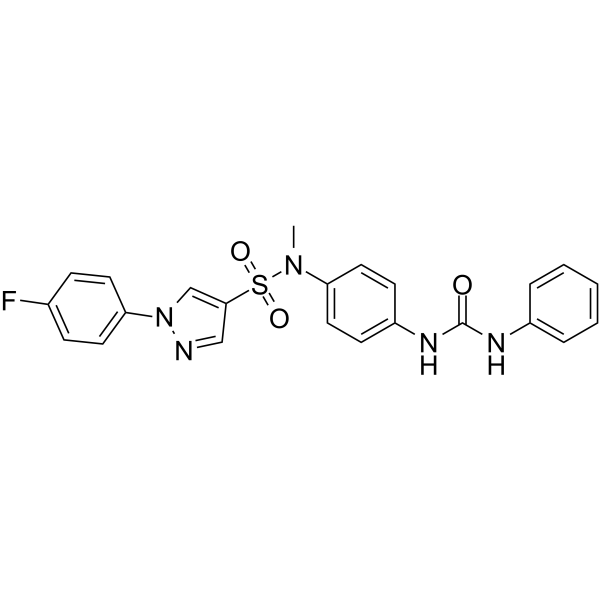1259028-99-3
| Name | 1-(4-Fluorophenyl)-N-methyl-N-{4-[(phenylcarbamoyl)amino]phenyl}-1H-pyrazole-4-sulfonamide |
|---|---|
| Synonyms |
1-(4-Fluorophenyl)-N-methyl-N-{4-[(phenylcarbamoyl)amino]phenyl}-1H-pyrazole-4-sulfonamide
1H-Pyrazole-4-sulfonamide, 1-(4-fluorophenyl)-N-methyl-N-[4-[[(phenylamino)carbonyl]amino]phenyl]- MFCD28166480 |
| Description | BTT-3033 is an orally active conformation-selective inhibitor of α2β1 (EC50: 130 nM) by binding to the α2I domain. BTT-3033 inhibits platelet binding to collagen Ⅰ and cell proliferation, and induces cell apoptosis. BTT-3033 can be used in the research of prostate cancer, inflammation and cardiovascular disease[1][2][4]. |
|---|---|
| Related Catalog | |
| Target |
α2β1:130 nM (EC50) |
| In Vitro | BTT-3033 (1 nM-100 μM, 2 h) inhibits CHO-α2wt cell adhesion to rat tail collagen Ⅰ (EC50: 130 nM), exhibits selectivity for α2β1 over α3β1, α4β1, α5β1 and αv[1]. BTT-3033 (10 μM, 5 min) inhibits human platelet binding to collagenⅠcoated capillaries under flow, with the EC50 value for mouse whole blood to be 6 μM[1]. BTT-3033 (10 μM, 5 min) inhibits binding of α2-expressing CHO cells to collagen Ⅰ under shear stress conditions[1]. BTT-3033 (1 μM, 60 min) inhibits of neurogenic and thromboxane A2‐induced human prostate smooth muscle contraction[3]. BTT-3033 (25 and 50 μM, 48 h) inhibits cell viability and proliferation by inducing G1 cell cycle arrest in LNcap‐FGC, and DU‐145 cells[4]. BTT-3033 (50 μM, 48 h) induces apoptosis through the activation of ROS, Bax protein upregulation, caspase‐3 activation, and depletion of ΔΨm[4]. BTT-3033 (10 μM, 15/28 days) suppresses MMP13 expression, increases the expression of MMP1 and MT-MMP1 in human articular cartilage‑derived chondrocytes[5]. Cell Viability Assay[4] Cell Line: LNcap‐FGC, and DU‐145 cells Concentration: 0.05, 0.5 5, 25, and 50 μM Incubation Time: 48 h Result: Decreased the cell viability at 25 μM and 50 μM. Cell Viability Assay[4] Cell Line: LNcap‐FGC, and DU‐145 cells Concentration: 5, 25, and 50 μM Incubation Time: 48 h Result: Induced cell apoptosis about 20%, 32%, and 47% (LNcap‐FGC) and 26%, 41%, and 59% (DU‐145) at 5, 25, and 50 μM. Western Blot Analysis[4] Cell Line: LNcap‐FGC, and DU‐145 cells Concentration: 25 μM Incubation Time: 48 h Result: Resulted in down-regulation of N‐cadherin and upregulation of E‐cadherin (EMT‐associated proteins). |
| In Vivo | BTT-3033 (oral administration, 10 mg/kg, at 24 h and 2 h before PAF induction) shows anti-inflammatory effects in mouse air pouch model[2]. BTT-3033 (oral administration, 10 mg/kg, at 48 ,24 and 2 h before ear swelling) shows anti-inflammatory effects in arachidonic acid-induced ear edema model[2]. Animal Model: PAF (platelet-activating factor)-induced mouse air pouch model[2] Dosage: 1, 10 mg/kg at 24 h and 2 h before PAF induction Administration: Oral administration Result: Reduced the infiltration of leukocytes by about 50% at 10 mg/kg. Animal Model: Male DBA/1 mice (Pharmacokinetic assay)[2] Dosage: 10 mg/kg for a single dose Administration: Oral administration Result: Plasma levels: about 1 ng/mL at 24 h post-dose. |
| References |
| Density | 1.4±0.1 g/cm3 |
|---|---|
| Molecular Formula | C23H20FN5O3S |
| Molecular Weight | 465.500 |
| Exact Mass | 465.127075 |
| LogP | 2.97 |
| Index of Refraction | 1.652 |
